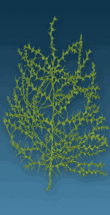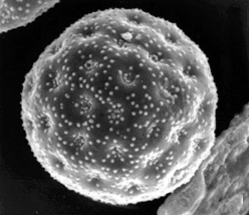Click on the name of a different pollen below to find out more about
it,
or click on the other microscope for a different view of this pollen.
| Plant: | Pollen: | Microscope: |
 |
 |
|
|
Russian Thistle This plant is the tumbleweed that blows across the movie screen in old westerns. In real life, tumbleweed is one of the worst hay fever culprits in the West, where the plant grows abundantly. Tumbleweed pollen is formed in flowers so tiny they are hard to see in the plant's tangle of branches. If you look closely, you'll find them growing in the angles where the leaf and stem meet. The male flowers make lots of tiny pollen, and the plant depends on the wind to spread the pollen to other tumbleweeds. How Russian thistle turns into a tumbling weed is an interesting story the movies don't tell. The process starts in spring when the young plant grows into a thick bushy ball. After flowering and forming seeds all summer, the plant dries up, breaks off at the root, and blows away in the wind. As it rolls around, it scatters seeds far and wide. When tumbleweed seeds came to the United States with settlers from Russia, they took root on the central plains. The plants then rolled up into Canada and down into Missouri. Soon they spread to California and the Pacific Northwest. Now Russian thistle grows just about everywhere on the continent, though it still grows best in the West. |